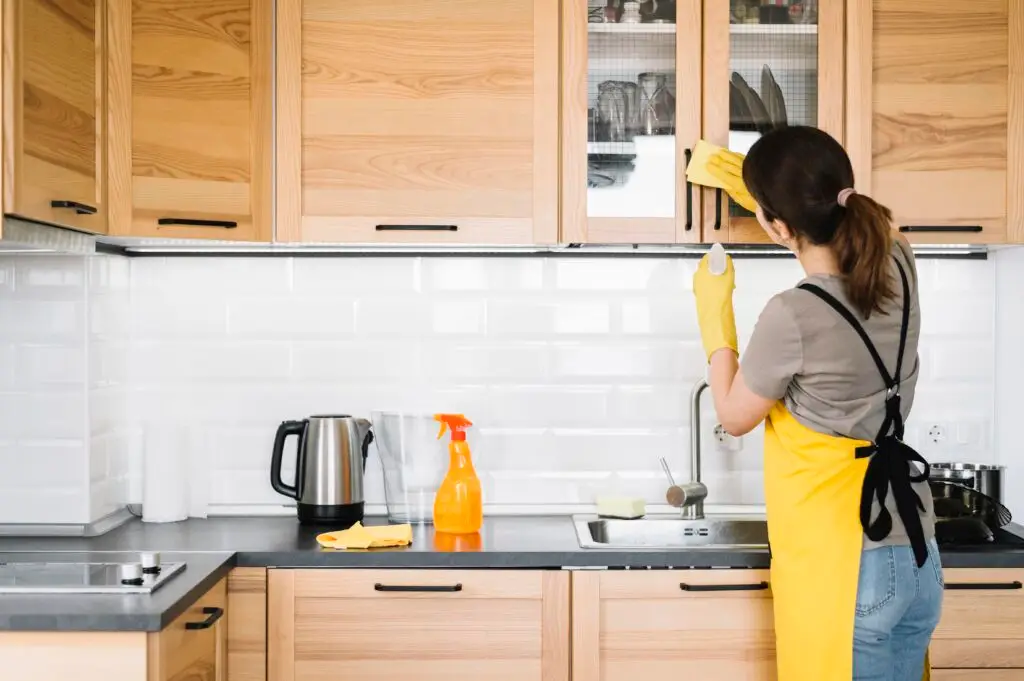Kitchen cabinets are the unsung heroes of your kitchen, providing storage and defining the space’s aesthetic. However, they also endure daily wear and tear, collecting grease, food splatters, and dust. Using the right cleaner is crucial to keep them looking their best without causing damage. Whether you prefer a store-bought product or a simple DIY solution, this guide will help you choose the best option for your specific cabinet type.
Why Cabinets Need the Right Cleaner
Avoiding Damage to Finishes
The finish on your cabinets, whether it’s a glossy paint, wood stain, or a laminate veneer, is sensitive to harsh chemicals. Using an incorrect cleaner—such as an abrasive scrubber or a product with ammonia—can strip the finish, cause discoloration, or even permanently damage the material. Choosing a cleaner specifically designed for your cabinet type ensures you protect your investment.
Removing Grease and Stains Safely
Kitchen cabinets, especially those above the stove, are magnets for grease and cooking residue. Simply wiping with water won’t cut through this sticky film. The right cleaner contains a degreasing agent that effectively breaks down grease and lifts stubborn stains without requiring aggressive scrubbing, which can scratch surfaces.
Best Store-Bought Cleaners
For those who prefer the convenience of a pre-made solution, many excellent products are available on the market.
For Wood Cabinets
Wood cabinets require a gentle touch. Look for cleaners specifically formulated for wood. Products containing orange oil or other natural oils are often a good choice, as they clean effectively while also nourishing the wood. Avoid anything with silicone, as it can build up over time, or harsh chemicals that can dry out the wood. Brands like Guardsman and Weiman offer popular wood-specific cabinet cleaners.
For Laminate and Painted Surfaces
Laminate and painted cabinets are more durable than wood but can still be damaged by abrasive products. The best cleaners for these surfaces are usually all-purpose, non-abrasive sprays. Look for a pH-neutral formula that is tough on grease but gentle on the finish. A simple solution like a mild dish soap and water mixture can also work wonders.
DIY Cabinet Cleaner Recipes
If you prefer a more natural and cost-effective approach, you can create effective cleaners using common household ingredients.
Vinegar and Water Solution
This is a classic all-purpose cleaner that works well on many cabinet types, especially laminate or painted surfaces.
- Recipe: Mix equal parts white vinegar and warm water in a spray bottle.
- How to Use: Lightly spray the solution onto a microfiber cloth and wipe down the cabinets. The vinegar’s acidity helps cut through grease and grime. For tough spots, let the solution sit for a minute before wiping.
Dish Soap and Baking Soda Mix
This is a fantastic option for tackling stubborn, greasy buildup.
- Recipe: Create a thick paste by mixing a few spoonfuls of baking soda with a squirt of mild dish soap and a little bit of water.
- How to Use: Apply the paste directly to greasy spots or tough stains. Let it sit for a few minutes, then gently scrub with a soft-bristled brush or a non-abrasive sponge. Rinse the area with a clean, damp cloth and dry thoroughly.
How to Clean Cabinets Properly
No matter which cleaner you choose, the technique you use is just as important.
Step-by-Step Process
- Empty the cabinets (optional but recommended): If you’re doing a deep clean, remove all items to access every surface.
- Start at the top: Work from the top of the cabinets down to catch any drips and dust.
- Apply cleaner to the cloth: Never spray the cleaner directly onto the cabinet surface. This can cause streaking and allows the liquid to seep into cracks, potentially causing damage. Instead, spray a microfiber cloth with your cleaner.
- Wipe and scrub gently: Use the damp cloth to wipe down the cabinet doors, fronts, and handles. For tough spots, use a soft-bristled brush or a non-abrasive sponge.
- Dry thoroughly: Use a separate, dry microfiber cloth to wipe down all surfaces. This step is crucial to prevent water marks and ensure no moisture is left behind to cause damage.
Tools and Techniques
- Microfiber cloths: These are the best tools for the job as they are highly absorbent, non-abrasive, and great at picking up dust and grime.
- Soft-bristled brushes: Use for getting into the nooks and crannies of cabinet hardware or decorative molding.
- Light touch: Always use gentle pressure. Aggressive scrubbing can scratch or dull the finish.
FAQs
Can vinegar damage wood cabinets?
Yes, vinegar can be too acidic for some wood cabinets, especially if they have a delicate finish. It can strip the sealant or dull the wood over time. For wood cabinets, a specialized wood cleaner or a mild dish soap solution is a safer bet. Use the vinegar solution primarily on laminate and painted surfaces.
How often should I clean my cabinets?
A light, routine cleaning of your cabinet fronts and handles can be done weekly or biweekly to remove surface grime. A deeper, more thorough cleaning—including the insides and tops of your cabinets—should be done every month or two, depending on how much you use your kitchen.
Don’t let stubborn grease and grime ruin your kitchen’s look. For a professional, stress-free clean, contact Maid Cleaning For You today. Our experts know exactly how to treat every surface in your home with the care it deserves. Get your free estimate now!


